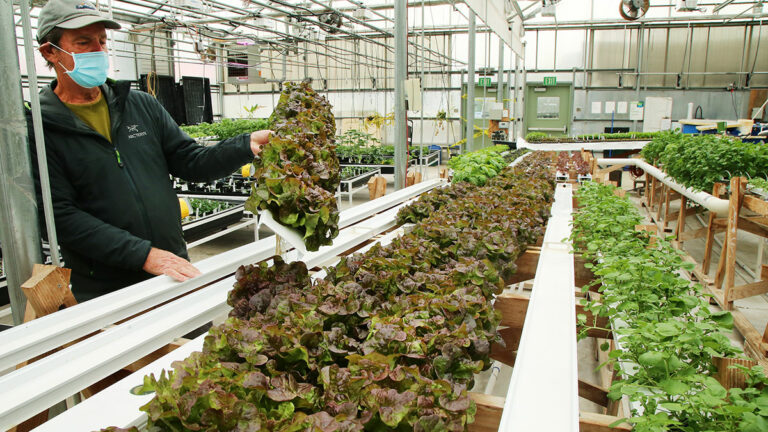Pedestrians wave and cars honk as we pass. With Bike Month banners trailing and music flowing through a portable speaker, the ride feels almost like a miniature parade. We peddle from Seabright to Soquel at a leisurely pace, stopping occasionally at neighborhood stop signs to regroup and talk about the roads ahead.
When we gather at the final destination, we talk about the ride. A few people head off to eat lunch with families and friends while others prepare to ride back together.
Safe Route Group Rides are the newest addition to Bike Month. Hosted by the environmental nonprofit Ecology Action, Bike Month began as a single day in 1987. Bike to Work Day encouraged people to reimagine their commute.
In the early 2000s, “it went from a day to a week of festivities celebrating the bike as a viable means of transportation,” says Ecology Action program specialist Matt Miller.
In 2019, Miller and colleagues at Ecology Action piloted the month-long Santa Cruz County Bike Challenge. By creating an account, logging rides online and encouraging other riders, people earn points that enter them into raffles. Prizes include gift certificates to local bike shops and $1,000 as a grand prize at the end of the month.
“The cool thing about how this platform is structured is it really rewards not prolific riders, not people who are going out and crushing 100-mile rides, but rather, regular riders, and enthusiastic riders,” says Miller. “Every day you ride, you get 10 points, regardless of distance.”
Steering toward sustainability
Ecology Action created the challenge with the goal of reducing emissions. “In the US, and in California, and in Santa Cruz County, the single largest source of greenhouse gas emissions come from transportation,” says Miller.
But Bike Month participants join for a variety of other reasons. Some people ride for their health. Others ride to spend time outside, explore new places or meet new people.
“I like the feeling of community,” says Miguel Aznar after one of the Safe Route Group Rides. Aznar has cycled for more than 30 years. A frequent group rider, he says he wouldn’t have changed a thing about the Bike Month ride.
“I loved the route. I really liked his description of how to handle the different situations. I liked how we stuck together,” he says. “People should come out and ride this and just see what it’s like to be on a bicycle in their community.”
Other, less experienced riders offer different takes.
“I love riding because it’s fun,” says three-year-old Isla Vilozny. She spent one of the group rides in a seat attached to her father Moshe’s bike.
Moshe Vilozny liked learning how to make group rides safer. “I think I took some ideas away for just riding with my wife and kids,” he says.

Finding new paths
The Saturday group rides filled up quickly. Waitlists formed almost immediately.
“I think they fill a gap for what we’ve been able to offer before,” says Miller. Riding through town with a group and learning how to find quieter routes, handle traffic and ride safer helps people build confidence, he says.
“There’s a lot of new riders who have started as a result of the pandemic—people who’ve rediscovered biking or found it for the first time,” says Miller. “So there’s a lot of people who are asking the simple question, ‘How do I get from here to there safely?’”
Because of the encouraging responses, Ecology Action might extend the program throughout the year.
“If it’s popular and people want this, we’re going to try to incorporate more regular Safe Route Group Rides,” says Miller.
He encourages everyone to give Bike Month a try, whether testing out a group ride, commuting to work or circling the block for fresh air.
“You don’t have to be an epic rider. You don’t have to be affiliated with a workplace,” says Miller. “If you go out and do one bike ride in May, that’s a win for you and for everybody else.”
See a list of Bike Month events and sign up for the challenge at ecoact.org/bikemonth.
























